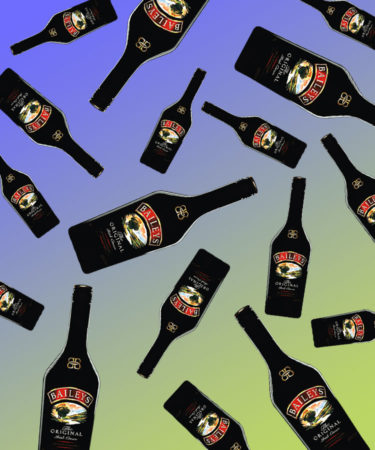The world’s first and best-selling cream liqueur, Baileys, launched in 1974. Drinks giant Diageo purchased it in 2007, and Baileys is now one of Ireland’s most successful exports.
Craving more? Read on for 14 other things you should know about Baileys.
Baileys isn’t as Irish as you think.
Baileys was invented in London in 1973 by a team of professionals hired for the job. These included Tom Jago, head of innovation and development for International Distillers & Vintners (IDV), who was from the U.K.; David Gluckman, a South African; and Hugh Seymour-Davies, an Englishman from Oxford and Eden. Gluckman and Seymour-Davies were hired by Jago to create a spirit that would become Ireland’s next export. Obviously, it worked.
Its name isn’t really Irish, either.
Instead, it was chosen to sound “Anglo-Irish,” Gluckman writes in the Irish Times. He and Seymour-Davies copied the name from Baileys Bistro, a restaurant located below the office they were moving into in SoHo, London. The bistro was owned by the team’s landlords, who were, according to Gluckman, “not an especially Irish pair.”
It’s global.
Today, more than 80 million bottles of Baileys are produced and packaged annually at the brand’s Dublin facility and exported to 180 countries worldwide. America is its biggest international customer, importing more Baileys than any other country.
A tax break gave Baileys its start.
According to an account by Jago, “The Irish government, in a successful rush for growth, offered a fifteen-year tax holiday to anyone exporting a new product or service, freely remittable. We were to produce something that could profitably be exported.”
IDV owned “the name and stocks of a small brand of Irish whiskey. A sister company owned a dairy plant in Cork; this plant had a waste product called cream,” he said, and then added: “Certainly, we did no research at all.”
Baileys’ ingredients are Irish — mostly.
Baileys Original Irish Cream is made with Irish dairy cream and Irish whiskey, but “the cocoa beans and vanilla extract that give Baileys its rich chocolatey taste are harvested in West Africa and processed in France,” according to Talking Retail.
Baileys comes in many flavors.
In addition to Baileys Original Irish Cream, year-round offerings include Baileys Salted Caramel, Baileys Espresso Creme, Baileys Chocolate Cherry, and Baileys Vanilla Cinnamon. Not to be outdone by other trends, the liqueur is also available in the seasonal Baileys Pumpkin Spice flavor, as well as the vegan Baileys Almande Almond Milk. Other innovations include a limited-edition Baileys Strawberries & Cream, Baileys Chocolat Luxe, and Baileys Dulce de Leche, the latter of which is sold exclusively in Mexico.
Farm to glass? More like cow to bottle.
To produce its creamy liqueurs, Baileys uses over 250 million liters of Irish whole milk annually. The milk is sourced from 40,000 dairy cows from 1,500 Irish farms, according to a 2015 report from Merrion Street, an Irish government news service. That cream reportedly arrives at Baileys’ Dublin facility 36 hours after leaving the farms. It stays fresh in the bottle for two years (sealed, of course).
Baileys may have started in a Schweppes bottle.
Gluckman told Irish Central that, after getting the call from the IDV, he and Seymour-Davies went to the nearest grocery store and purchased Jameson Irish Whiskey, Cadbury’s Powdered Drinking Chocolate, and cream. They mixed it up in a cleaned-out Schweppes bottle, and the rudimentary recipe for Baileys was born.
At least five men are credited for creating Baileys.
David Gluckman, David Dand, Mac Macpherson, Steve Wilson, and Tom Jago are among the men who either claimed to be, or have been credited as, Baileys’ creator.
Perhaps the most credible is Jago, a spirits pioneer who, with James Espey, also launched such successful brands as Johnnie Walker Blue Label and Malibu. Jago and Espey were also co-founders of The Last Drop Distillers Limited.
Per Jago’s telling, Gluckman and Seymour-Davies were copywriters; Macpherson was a chemist; Wilson was Macperson’s assistant; and Dand was Macpherson’s and Wilson’s boss. All contributed. “But certainly,” Jago writes, “David [Gluckman] was the man who took the idea forward, and with Hugh [Seymour-Davies], assembled not just the liquid (Irish whiskey, cream, sugar and chocolate), but the name … and a label, almost exactly as it is to this day.”
Baileys was reportedly created for women.
We’re not sure what about “whiskey” and “cream” screams “for females,” but Baileys creators Gluckman and Jago allude to it as a “girly drink,” and “a woman’s drink,” respectively. In 2014, Baileys launched a female-focused ad campaign, “Here’s to us,” created by a largely female team at Diageo and at BBH London. The ads were “designed to introduce a new generation of Millennial women to the brand,” Irish Central reports.
You can have Baileys for breakfast.
In January 2019, Baileys introduced Baileys Irish Creamers, a Coffee Mate-esque line of (non-alcoholic) coffee creamers made with milk and cane sugar. Flavors include the Original Irish Cream, Vanilla Cream, and Mocha Mudslide. In July 2019, Baileys announced the launch of canned cold-brew coffee, available in Salted Caramel and Original Irish Cream flavors, also sans booze.
Or, you can save it for dessert.
Baileys is incorporated into dessert recipes including cheesecake, brownies, and frozen yogurt. In 2018, Baileys even launched its own line of semi-sweet chocolate baking chips.
Baileys is not an Irish coffee ingredient.
Contrary to popular belief, Baileys is not an “official” ingredient in a traditional Irish Coffee. That recipe calls for Irish whiskey, simple syrup, coffee, and cream.
Bartenders love Baileys.
The Bartender Influencer Study, an annual survey of 10,000 U.S. bartenders, revealed that Baileys was the most recommended coffee cordial in 2018. Brands currently challenging the Irish cream liqueur include Five Farms Irish Cream of Ireland’s County Cork, and Nooku Bourbon Cream of Colorado, but so far, there’s nothing like the original.
